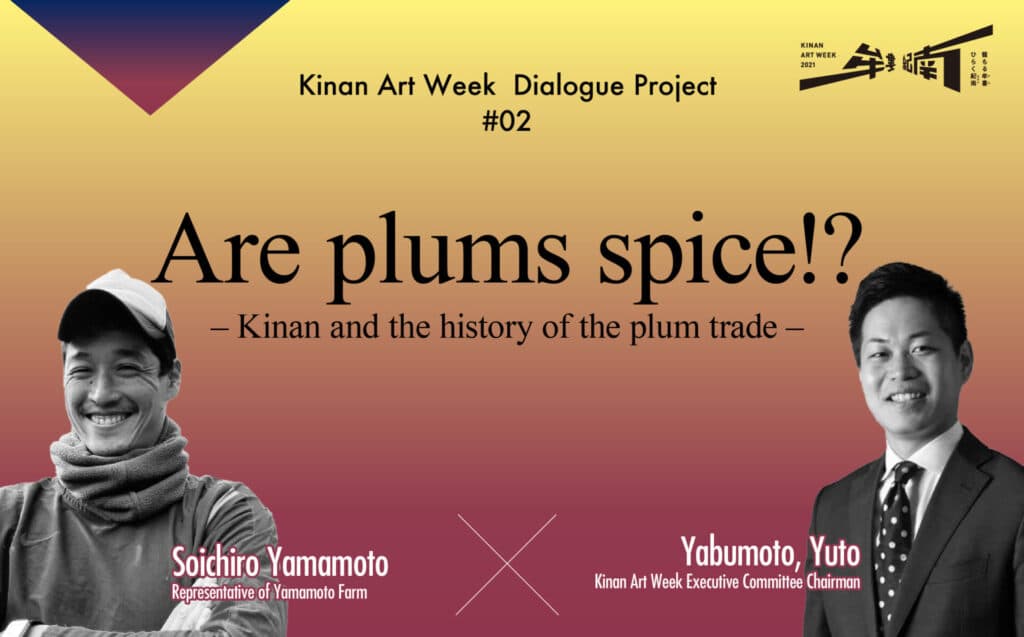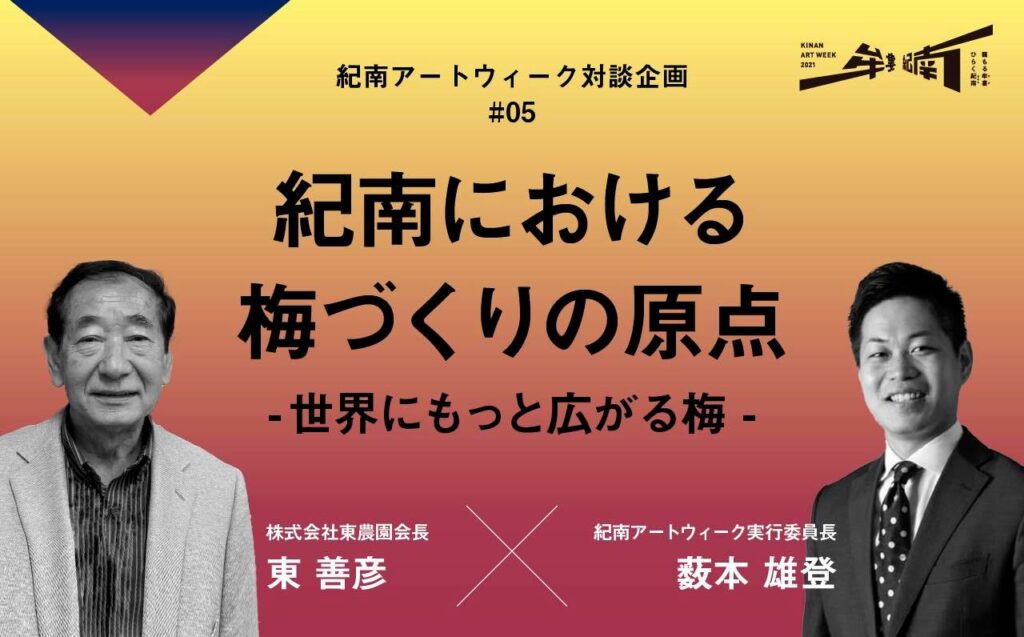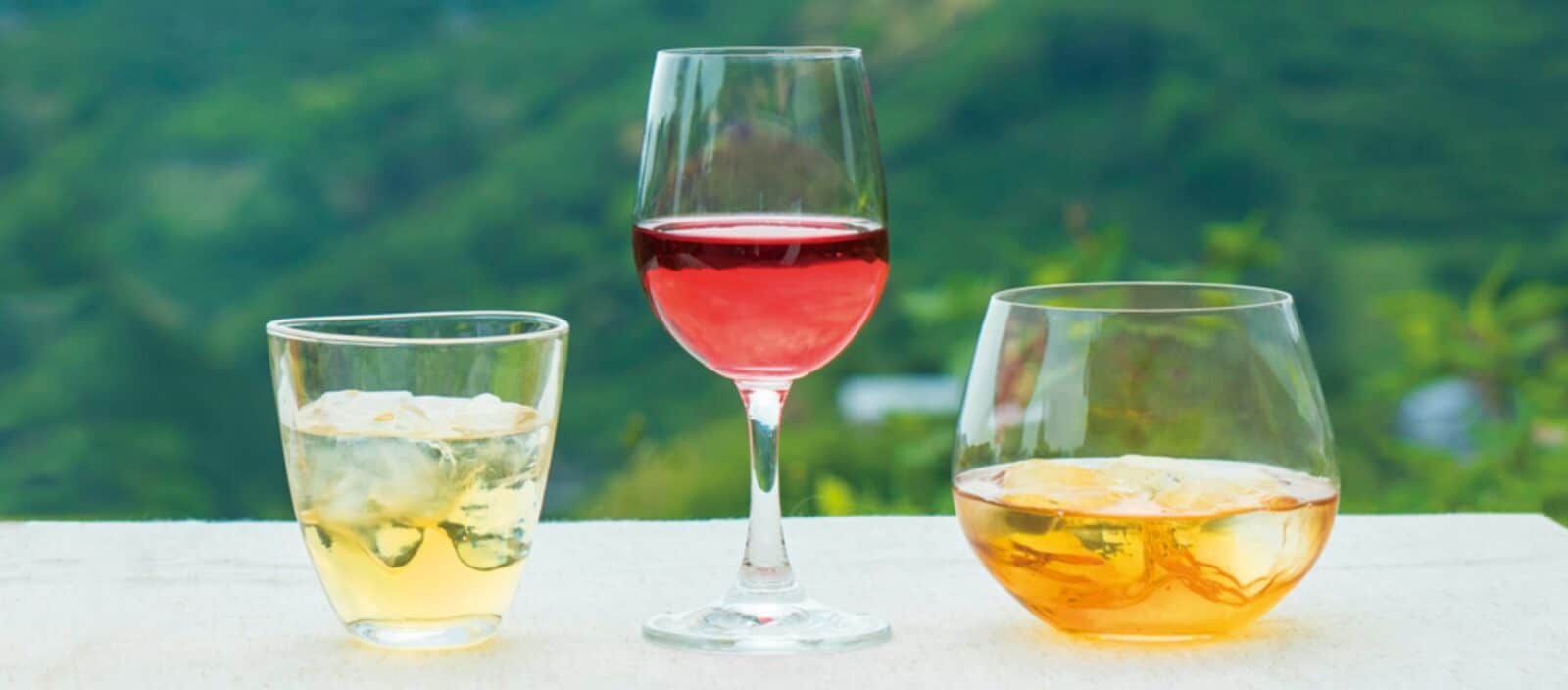
#33 The Value of Plum Wine and Art
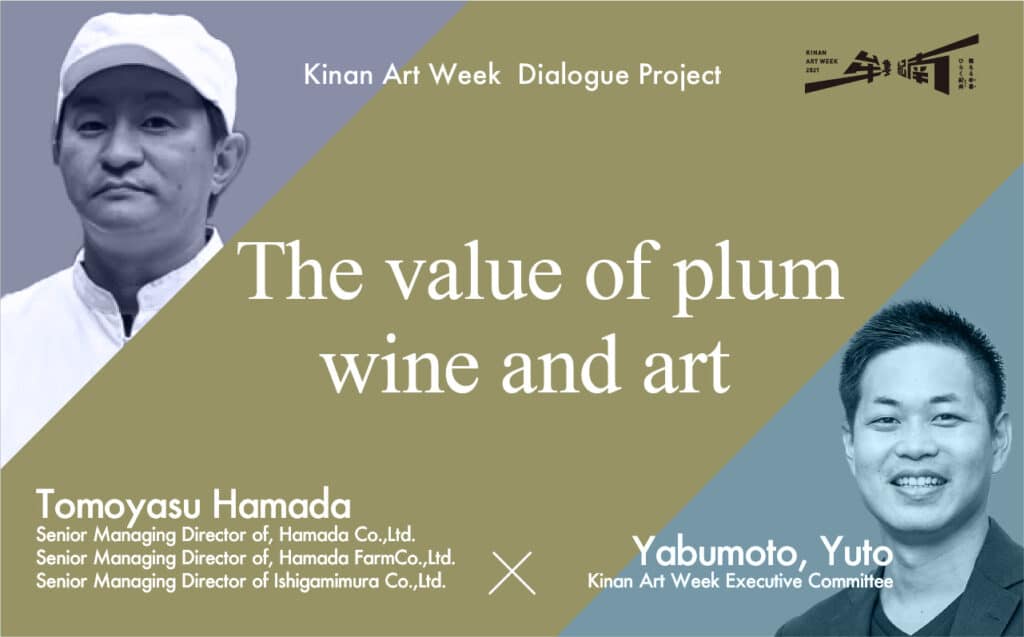
Kinan Art Week Dialogue project #33
<Guest>

Senior Managing Director of Hamada Co.,Ltd.
Senior Managing Director of Hamada Farm Co.,Ltd.
Senior Managing Director of Ishigamimura Co.,Ltd.
Mr. Tomoyasu Hamada
His company manufactures and sells umeboshi and plum wine in the Ishigami area of Tanabe City. They export their plum wine mainly to Asia and their main aim is to become the “King of Plum Wine in Asia”. Mr. Hamada is striving to convey the appeal of Wakayama plum wine to the world, and hopes to develop a “Wakayama liqueur” using Wakayama fruits.
https://ume-hamada.co.jp/
<Interviewer>
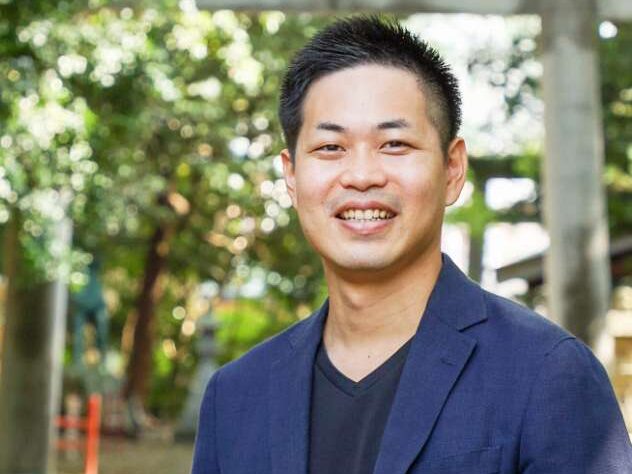
Yuto Yabumoto
Kinan Art Week Executive Committee Chair
<Participants>
Mariko Sugi
Vice-chairman of Kinan Art Week
Manabu Shimoda
Executive Director of Kinan Art Week
The Value of Plum Wine and Art
Table of Contents
1. Introduction of Mr. Hamada
2. Aiming to become the “King of Plum Wine” in Asia
3. Plum wine maturing and “Wakayama liqueur”.
4. Ume as a spice
5. How to sell a bottle of plum wine for 1 million yen?
6. As an interpreter for farmers
7. What to expect from Kinan Art Week
1. Introduction of Mr. Hamada
Yabumoto:
Thank you very much for your time.
Today we would like to ask Mr. Hamada what he does on a daily basis and what the value of plum wine is.
First of all, please introduce yourself, Mr. Hamada.
Mr Hamada:
My name is Tomoyasu Hamada. I am from the Ishigami area, which is located deep in Kamihaya, Tanabe City. Kamihaya itself has a population of less than 2,000 people*, but Ishigami has even fewer, with only 13 households in total. I came back to Ishigami from Okinawa when I was 30 years old, and it’s been about 13 years now.
Yabumoto:
What did you do when you were living in Okinawa?
Mr Hamada:
I did research on marine microorganisms in Okinawa when I was a graduate student, and after graduating I worked for a general company. I went to Tanabe High School and when I was in my third year of high school, I was thinking about where to go to school and the family business came to my mind. At that time, my father had already incorporated the family business, and I thought that even if I went on to study economics or business administration, I would not be able to help him.
I then switched from the humanities to the sciences and went on to study at the Faculty of Agriculture at Kinki University. When I was a graduate student, I first went to Okinawa for only two weeks because I learned that it was easy to find new species of creatures in the sea of Okinawa while studying marine microorganisms. At that time, I liked Okinawa so much that when I was looking for a job in Okinawa, I was employed by Sanei Co.,Ltd. *, a supermarket in the Nichiriu Group*, and worked in the Corporate Planning Department for five years before returning to Ishigami.
*Reference: Member companies: Domestic Group Power (Japan Distribution Industry Co., Ltd.)
*Reference: Sanei Co.,Ltd.
After I returned to Ishigami, I found that my neighbours, who looked after me when I was a child, were getting old, and I often heard people in the community talking about how hard it was to farm. Ishigami has many steep slopes, and we felt that if fewer and fewer people continued to work on the farm, Ishigami would disappear. I had a sense of crisis. I didn’t want to lose my hometown, so I continued to work in Ishigami.
Yabumoto:
Hamada Co.,Ltd. was established in 1988*. What are the current business activities of the company?
※Reference Company Profile: History (Hamada Co.,Ltd.)
Mr Hamada:
We are mainly engaged in the manufacture and sale of umeboshi and plum wine. We also operate “Hamada Farm Co., Ltd.*” which grows ume on its own farm, and Ishigamimura Co.,Ltd. At present, Hamada Farm is accepting six technical trainees from Vietnam*, who are very enthusiastic about farming.
*Reference: Hamada Farm (Hamada Co., Ltd.)
*Reference: Umeboshi Specialty Store Ishigamimura Official Website
Yabumoto:
I once heard someone say, “Isn’t it difficult for technical trainees in Kinan, from a regulatory point of view, to combine farming work with factory work?” . I thought this was the reason why Wakayama Prefecture, where the ume industry is flourishing, was not accepting many trainees.
*Reference: What is the Technical Internship System for Foreigners (Japan International Cooperation Agency)
*Reference: Technical Internship System Occupations and Tasks (Japan International Cooperation Agency)
Mr Hamada:
In fact, in recent years, the number of accepted trainees has increased in recent years.. I think there are about 50 people, mostly Vietnamese, in the Kinan region alone.
Yabumoto:
Are the trainees able to live in harmony with the people of Ishigami? According to the data, we hear that “many Vietnamese trainees run away from their training placements”. Also, actually, when I was a university student, I was interested in international labour law and immigration law, and I have interned at the ILO (International Labour Organization)* and IMO (International Organization for Migration)* in Geneva. In Japan, I’ve done research on the actual situation of trainees at a farmer in Nagano Prefecture and a sewing business in the Kyushu region. That’s a long time ago.
*Reference International Labour Organization (ILO)
*Reference International Organization for Migration (IOM)
Mr Hamada:
It’s been about five years now, and we haven’t had any trainees run away at all. Perhaps it’s because Ishigami is a remote area, so they can’t escape (laughs). I think it has something to do with the fact that the trainees and the local people have deepened their relationship by talking to each other, sharing local vegetables and so on.
Yabumoto:
That’s really great.
2. Aiming to become the “King of Plum Wine in Asia”.
Yabumoto:
What initiatives are you currently focusing on in particular?
Mr Hamada:
For several years now, Ie have been focusing on making plum wine and selling it abroad. I had never been abroad before, but I was inspired by the success of Osaka’s Choya Umeshu Co.,Ltd.* abroad. I visited Asian countries such as South Korea and Hong Kong for the first time in 2015.
*Reference: Choya Umeshu Co., Ltd.
I decided to try and sell our products in areas where Choya didn’t have a business presence, so in 2016 I dived into Myanmar to sell our plum wine. But I wasn’t n’t allowed to advertise cigarettes and alcohol there, , so I made sales to the local Japanese people instead.
Truth be told , ume grow wild in Myanmar too. When the local people eat ume, they pickle them sweetly and eat them as sweets*. However, I thought it would be a shame to leave it at that, so I tried making plum wine together and it was very popular, so I would like to continue to share the appeal of plum wineand ume processing techniques with people overseas.
Yabumoto:
Besides Myanmar, are there any other countries to which you export plum wine?
Mr Hamada:
China, Hong Kong, Thailand, Taiwan, Vietnam and Singapore. We are mainly targeting the Asian region. I tell people around me, “I’m going to be the king of plum wine in Asia!” (laughs).
When I visited Bangladesh, even though most of the population is Muslim, I saw people drinking alcohol in secret. “I felt that drinking alcohol is a common pleasure for all human beings, regardless of religion”, and I felt that exporting plum wine is meaningful just because it has the potential to be close to the local culture and create a new culture.
3. Plum wine maturing and “Wakayama liqueur”.
Mr Shimoda:
How long does your company age your plum wine, Mr Hamada? And does the ageing increase the value of the plum wine?
Mr Hamada:
We have some plum wine that has been maturing for about 16 years, and we will continue to think about what to do with it. According to the rules of the world of alcohol, the longer it is aged, the higher the premium, so the value of the plum wine increases with age. When you drink the aged plum wine, you will notice that it has a mellower taste with less the edge.
In the future, we would like to find out “how to blend and make it tasty” rather than just maturing it. In the future, I would like to make “Wakayama liqueur*”.
*Reference: Introduction of students (Tanabe Miraisozojuku 5th term)
*Reference: “What does it mean to edit a region? The students of the “Tanakoto Academy” put it into practice! (July 20, 2021, Sotokoto)
Mr Shimoda:
What kind of liquor is Wakayama liqueur?
Mr Hamada:
In a nutshell, it’s a liqueur made from a blend of fruits from Wakayama. Wakayama Prefecture produces a lot of fruit, but among the harvest there are some that can be shipped as goods and some that cannot. Some producers discard the fruit that are not for sale or sell them cheaply, but by processing such “unqualified fruit” it is possible to make a delicious liqueur.
Liqueurs are made by extracting sugar and alcohol by osmotic pressure. As long as we have the production technology and license*, we can create new liqueurs using Wakayama fruits. I think it is important to explore the possibilities of combinations, for example, a blend of plum wine and plum.
*Reference: Special fruit wine and liqueur zone in Tanabe, Kishu (9 July 2020, Tanabe City, Wakayama Prefecture website)
Mr Shimoda:
Is it slightly different from Kacho-Fu-Getsu and Murabito, which are sold by Mr Hamada’s company?
Mr Hamada:
So these products are based on plum wine and added fruit juice. We would like to improve our liqueur making technique so that we can introduce not only plum wine but also other drinks made from Wakayama fruits as “Wakayama liqueur”.
Mr Shimoda:
If you can develop a liqueur from a fruit that is not suitable for pickling, or a fruit that no one has used before, it could become a dominant brand.
Mr Hamada:
What I personally find interesting is the sansho. Our drinks are often described as ‘sweet’, and while sweetness makes them easy to drink, it also makes them difficult to drink in large quantities. We think that sansho can make up for this.
4. Ume as a spice
Yabumoto:
I know this is a bit of a departure from the topic of plum wine , but I would like to ask you a question: “What about ume as a seasoning?” Some argue that ume was originally a spice, and some argue that ume should be similar to pepper and salt, but ume is not branded as such..
Mr Hamada:
Historically speaking, ume vinegar was used to clean the Great Buddha in Nara*. This is an interesting thought, and in fact, I think that ume can be used as a seasoning.
When “edible seasonings” became popular in the past, our company developed products and we still make “ume dressing”, but we may be able to explore ume more deeply as a seasoning. Also, “Ume Abura (plum oil)” is a product that we made because we wanted to match it with western food, even though the consumption of ume is decreasing. Ume is often expensive and people don’t eat it, so we made this product to bring the taste of ume to people’s mouths for about “one coin (500 yen)”.
Mr Shimoda:
If you use it in the right way, it can make a big difference to the taste of your food.
Mr Hamada:
Originally, umeboshi were pickles and savoury foods, and in my opinion they are a “supporting role” that can add flavour to any dish, so I think that umeboshi have potential as a seasoning.
I believe that human beings have an instinct that sour food is rotten and poisonous, so the body resists it. On the other hand, people actively consume sugar, recognising that sweet foods are nutritious. The question is how to get sour food into the body, and I hope that our ume products will help.
5. How to sell a bottle of plum wine for 1 million yen?
Yabumoto:
Although the theme of this Kinan Art Week is “Export”, our idea is not a “market-in” thinking. Our strategy is not to localise plum wine and sell it cheaply, rather we are very interested in “how would you make plum wine that costs a million yen a bottle?” I’m very interested in that. Mr Hamada, I want to know how you would make a bottle that would sell for such a price?
Mr Hamada:
I think it is necessary to introduce the culture of ume making that Wakayama is proud of, such as ume cultivation and processing techniques, and to enhance the value of plum wine. For example, if I wanted to introduce the charm of champagne, I would talk about the culture and process that goes into making a bottle of wine. In that sense, I’d like to convey not only the taste, but the story that goes into each bottle of plum wine.
*Reference: La WINEista: “[Summary] France in 5 minutes: Champagne in 5 minutes” (France.fr, April 21, 2021)
Yabumoto:
If we can find the value in the fact that small local makers are creating products, I think we can incorporate the story in the same way in Wakayama. I think that if we can successfully communicate the stories we have created, plum wine will spread all over the world at once, and there is a possibility that plum wine worth one million yen per bottle will be born.
Mr Hamada:
In my opinion, an artistic product is one where the object itself is so wonderful that it attracts people and is bought subconsciously . I believe it is important for us to create and organise a story in order to sell such products.
We also hope that we can do something else, like art, that will grab people’s attention. We are working on redesigning our products and gift packaging and collaborating with other companies* to make our ume products more appealing to our customers, but if there is something else we can do, we would like to try it.
*Reference: Kishu Ippindo (Japanese umeboshi specialty shop Ishigamimura official website)
*Reference: Bihin Hyakka: Nakagawa Masashichi Shoten (Umeboshi Specialty Store Ishigamimura official Website)
Yabumoto:
The artists, in a way, don’t explain it at all. So maybe you don’t have to explain much about that either.
Mr Hamada:
In the case of art, even if the artist doesn’t say anything, there are people who sympathise with the work and understand its value. In the world of commerce, this is a very happy thing. It’s not easy to get people to say “I want to drink Hamada’s plum wine because it’s Hamada’s plum wine”, but we want to keep making plum wine that more and more people can relate to, so that we can say “Our plum wine is the story itself”.
6. As an interpreter for farmers
Yabumoto:
In fact, I have a hypothesis that farmers are artists. When you think about it, vegetables and fruits grown by farmers can be seen as “works of art”. I think it is necessary to spread the “artworks” created by farmers to the world, based on the history and culture of the region.
Mr Hamada:
As the old saying goes, “Steal with your eyes”. I think that farmers are artists precisely in the sense that they “make with their senses”. The description and design of our products are there to help people understand this “sense of the creator”. When we make ume products, we try not to embellish them too much, but try to convey the feelings that go into them.
In this sense, I would like to continue to be an “interpreter” for the farmers, telling people what kind of place, what kind of cultivation techniques and what kind of farmers are producing the ume. I believe that by telling the story as it is, more and more people will be able to relate to the farmers’ thoughts.
However, the main actor is the farmer, not the interpreter. In business, it is often the interpreter, not the person using the difficult words, who is seen as the boss, and the person who knows the essence of the matter as the fool. Interpreters are just explaining things, and I hope that during my time as a farmer’s interpreter I will not lose sight of my true role as an interpreter.
Mr Shimoda:
Perhaps Mr Hamada is both an “interpreter” who sells ume products and a “party” who grows ume at your own farm. Your words really resonate with me, so I think that your ability to convey your thoughts in a straightforward and easy-to-understand manner is an amazing power that you possesses.
Mr Hamada:
Thank you very much. When I think about what my role is again, I think it is to talk to as many people as possible and spread the word about my hometown Ishigami and Wakayama. If I were to become conceited and start saying “I am good at farming” or “I make very good plum wine”, my company would go bankrupt. That’s why I try to tell the truth about everything, without any falsehoods, and I’m proud to say that I don’t mind what I say being published anywhere.
7. What to expect from Kinan Art Week
Yabumoto:
Are there any expectations you have for Kinan Art Week?
Mr Hamada:
When it comes to art events, I want to be able to say “I’m glad I went!” I myself think that art is a kind of “culture”, and people who are interested in art are people who seek culture. I once went to the Setouchi International Art Festival*, and although I didn’t know much about art, I felt that I should go because it looked interesting. I hope that the event will be enjoyable for people who visit because they are interested in art, regardless of their knowledge.
*Reference ART SETOUCHI
Ms Sugi :
I have also been to the Setouchi International Art Festival. I really like museums themselves, but I’ve never been that interested in contemporary art. However, now that I am involved in Kinan Art Week as the vice-chairman of the committee, it has become my personal mission to “convey the fun of contemporary art”, albeit from a beginner’s point of view.
Mr Hamada:
I myself like to take part in events. I once opened a plum wine bar at Kinokuni Trainato 2019*. Talking to people is half of my job, so I’d like to continue to actively open stalls at various events in the future, as it gives me more opportunities to meet people.
Mr Shimoda:
In addition to exhibiting artworks at Kinan Art Week, I myself would like to implement tie-up initiatives with local shops as a sub-project. Not only to collaborate with us, but also to connect with other shops in the area and to revitalise the whole area. Do you have any restaurant recommendations?
Mr Hamada:
By far, it’s “Nanki Shirahama Tsukumo*”. It is a shop that I myself worship, and now I feel that there is no place to compete with Tsukumo.
*Reference Milk & Beer Hall Tsukumo
*Reference: Mame no Yu (The Tsukumo Villa)
*Reference Nanki Shirahama inn Tsukumoso
As I said, I think it’s great that the shops in the area are working together, because many of them are trying to do something on their own.
Ms Sugi :
Surprisingly, there are many people who don’t know that there are those who are working hard in the region. By forming a network in the Kinan region, not only for art but also for sub-projects, we may be able to become aware of the “good things” in the local area.
Also, we are currently in the process of planning original Kinan Art Week products and souvenirs. We think it would be interesting to collaborate with Mr Hamada and create something together.
Mr Hamada:
Please let us know if there’s anything we can do! We’ll help!
If we are going to make something related to Kinan Art Week, we would like to get a lot of opinions from you. Because without discussion, we can’t create a good product.
We look forward to working with you in the future.
Yabumoto:
We look forward to working with you.
I learned a lot from you today. Thank you very much!

